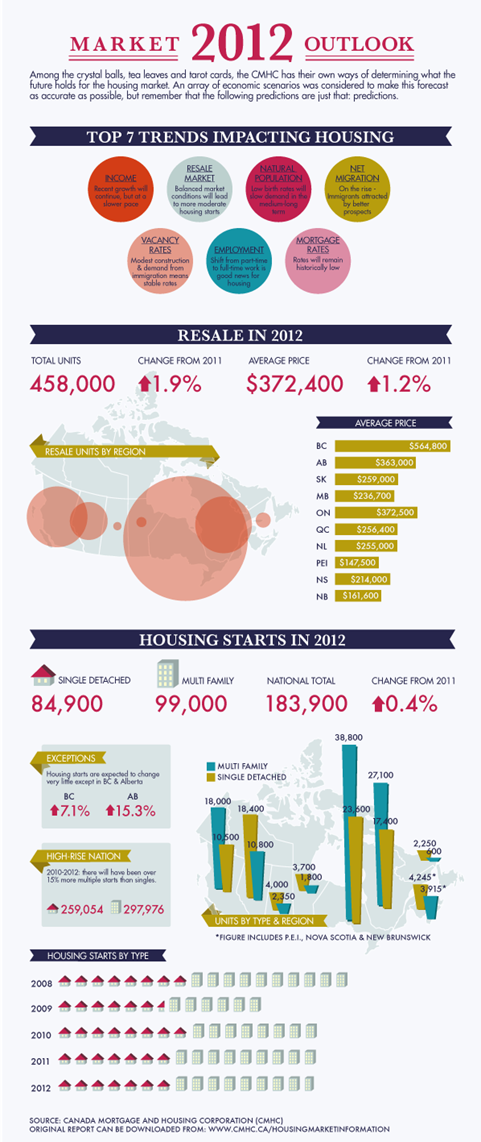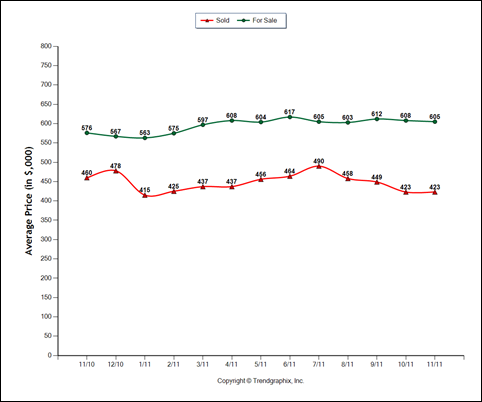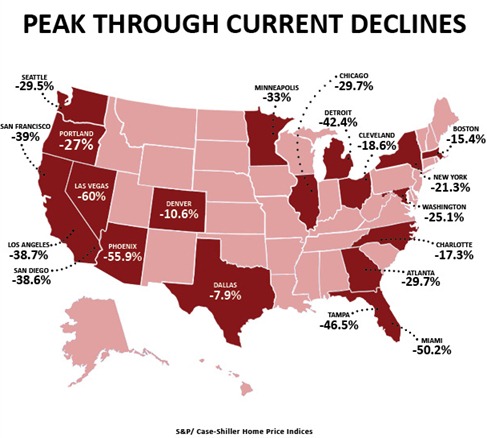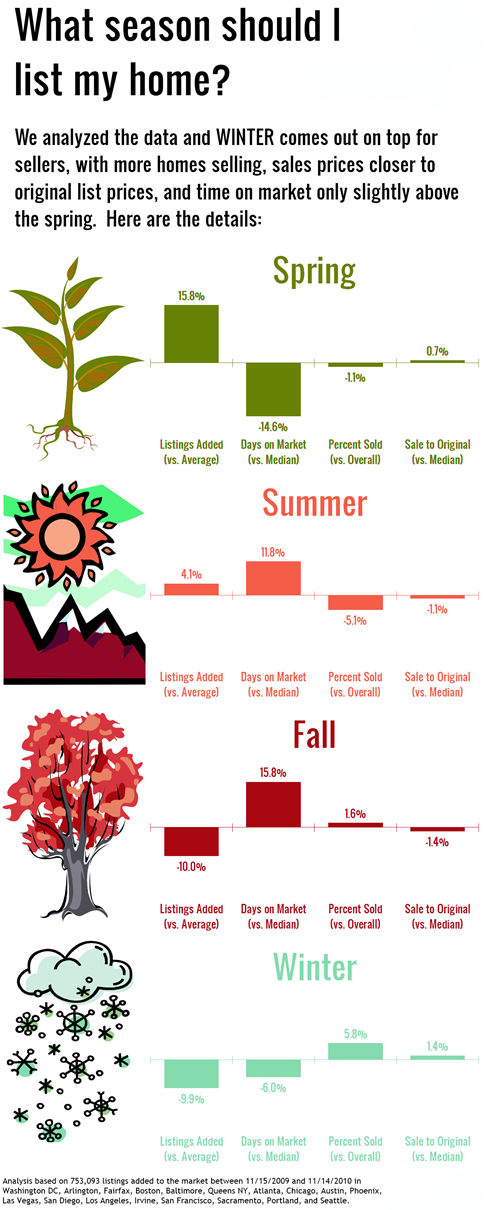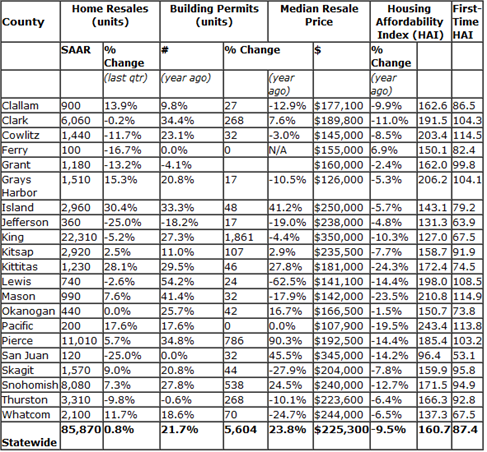Canada’s housing market predictions for 2012
7 Cities Where List Prices Are Falling the Most
 With the Seattle Times announcing yesterday the 1% decrease in home prices, a look at what is happening elsewhere seems to be in order. Nationally, median list prices have mostly been flat since June, but some markets are still seeing some decreases in home prices, according to the latest data from Realtor.com of 146 metro markets.
With the Seattle Times announcing yesterday the 1% decrease in home prices, a look at what is happening elsewhere seems to be in order. Nationally, median list prices have mostly been flat since June, but some markets are still seeing some decreases in home prices, according to the latest data from Realtor.com of 146 metro markets.
The following are the cities where list prices have fallen the most from October to November:
1. Detroit
Month-over-month decrease: -4.61%
Year-over-year decrease: -12.47%
Median list price: $84,900
2. Monmouth-Ocean, N.J.
Month-over-month decrease: -4.32%
Year-over-year decrease: -3.05%
Median list price: $300,444
3. Santa Barbara-Santa Maria-Lompoc, Calif.
Month-over-month decrease: -3.52%
Year-over-year decrease: -1.95%
Median list price: $539,250
4. Pueblo, Colo.
Month-over-month decrease: -3.45%
Year-over-year increase: 0.29%
Median list price: $139,900
5. Tulsa, Okla.
Month-over-month decrease: -3.38%
Year-over-year decrease: -5.34%
Median list price: $140,000
6. Peoria-Pekin, Ill.
Month-over-month decrease: -3.18%
Year-over-year increase: 3.71%
Median list price: $139,900
7. Charleston, W. Va.
Month-over-month decrease: -3.09%
Year-over-year increase: 6.67%
Median list price: $159,900
Prices Down? Really?!
So once again, the news has reported that “Seattle home prices are down". “according to another index”. I was the kid in the class that would question everything. Sorry teachers, that was me. I had to ask the question, is that really true? The “index” that is being quoted is the Case-Shiller index. Seattle, in this index is hardly in context…
I am not a fan of the U.S. housing index created by Karl Case and Bob Shiller (in the early 1990s). That said, it is a highly watched gauge and worthy of commentary.
It is worthwhile discussing briefly exactly what is tracked and how it is put together. The indices are calculated from data on repeat sales of single-family homes; that is the sale of the same house over time (it therefore ignores the new construction market completely). The Case-Shiller index family includes 20 metropolitan area indices and two composite indices as aggregates of the metropolitan areas. These indices are three month moving averages and data is published with a two-month lag.
My biggest concern with the Case-Shiller report is really a local one. Since I am based in the greater Seattle area, which is one of the “cities” within the index. My issue is that Case-Shiller defines Seattle as the tri-county area – encompassing King, Snohomish, and Pierce Counties. In most people’s opinions, this is far too large a geography to have any real relevance. The markets in these three counties vary significantly from each other, so to define what is taking place in Seattle using sales activity in Tacoma and Everett seems ridiculous to me.
You can read the rest here.
While I do believe there are many a deal to be had in our present situation. The negative news does not put context into their reporting.
If you would like to discuss the local market and the possibilities for you and those you care about, call or email me.
Home Price Changes Across The Country
The graphic depicts pricing of all homes from their ‘peak through current declines’ as per Case Shiller. This index looks at prices in 20 major metropolitan areas. Keep in mind that for what is categorized as “Seattle” is comprised of Snohomish, King and Pierce Counties.
Each market peaked at different times. Therefore, the InfoGraphic doesn’t cover one segment of time. Here is a site where you can see when each market actually peaked:
Housing Affordability at Record Highs, According to Report from WSU
 Homes in Washington state are at record high affordability, thanks to the combination of lower prices and record-low mortgage interest rates.
Homes in Washington state are at record high affordability, thanks to the combination of lower prices and record-low mortgage interest rates.
A report on the Housing Affordability Index (HAI) for third quarter 2011 showed a statewide index of 160.7, which means a median income family had 60.7 percent more income than the minimum needed to qualify to purchase a $225,300 home (the estimated median-price).
Comparing counties, the HAI ranged from a low of 96.4 in San Juan County, where the median priced home sold for $345,000, to a high of 459.4 in Wahkiakum County, where the median price for third quarter sales was estimated to be $62,500.
The index, prepared by the Washington Center for Real Estate Research, assumes a 20 percent down payment and a 30-year mortgage.
The HAI for counties served by Northwest Multiple Listing Service shows a range of 96.4 (San Juan County) to a high of 243.4 in Pacific County. As revealed in the chart, first-time buyers remain challenged, with the statewide index pegged at 87.4.
WCRER’s report shows a three-year downward trend in prices, including a 9.5 percent drop in the statewide median sales price for Q3 compared to same period in 2010. Prices range from King County’s high of $350,000 to a low of $62,500 in Wahkiakum County.
The WCRER was created in 1989 by the WSU Board of Regents to achieve the university’s tripartite mission of education, research and service in real estate. The Center strives to provide a wide range of useful and understandable information, analysis and knowledge using academic methods in practical context while reporting findings in common language.
HOUSING MARKET SNAPSHOT
State of Washington and Northwest MLS Counties - Third Quarter 2011
NOTES:
- Home Resales are WCRER estimates based on MLS reports or deed recording (Real Market Data LLC)
- SAAR means data presented at Seasonally Adjusted Annual Rates allowing quarter-to-quarter comparison.
- Building permits (total) are from the U.S. Department of Commerce, Bureau of the Census
- Median prices are WCRER estimates. Half the homes sold at higher prices, half lower
- Affordability index measures the ability of a typical family to make payments on median price resale home. It assumes 20% downpayment and 30-year amortizing mortgage. First-time buyer affordability index assumes a less expensive home, lower downpayment and lower income.
Three Quarters of Owners Continue to Overvalue
 Despite survey after survey showing that consumers expect home prices to continue to decline next year, most home owners still believe their houses are worth more than what their agents recommend.
Despite survey after survey showing that consumers expect home prices to continue to decline next year, most home owners still believe their houses are worth more than what their agents recommend.
Nearly three out of four home owners, 76 percent, believe their homes are worth more than the recommended agent listing price. By contrast, 68 percent of home buyers believe homes are overpriced, according to the latest HomeGain. Thirty-two percent said homes are overpriced by more than 10 percent.
The gap between what sellers expect and what agents recommend has actually grown slightly over the past year even though national median prices have declined about 4-7 percent this year. A year ago, some 73 percent of owners thought their homes were worth more than their agent’s recommended listing price and 69 percent of buyers thought homes were overpriced.
“The market in the Syracuse, NY area is classified as a buyers market. Sellers are still not understanding the importance of proper pricing as most sellers properties are priced 5 to 10% over market value,” said one professional.
“Seller pricing is not necessarily the problem. The issue is making it possible for buyer candidates to buy a home. More buyers equal better quality offers. The credit system needs to be reinvented,” commented another.
Forty-two percent of real estate agents and brokers and 37 percent of homeowners think that home values will decrease in the coming six months. Only 15 percent of real estate professionals expect home values to increase in the next six months, up four percent from last quarter. Fifteen percent of home owners also expect home values to increase in the next six months, up three percent from last quarter.
“Home owners and real estate professionals appear to be in sync regarding the direction of home prices. Home buyers and sellers, however, continue to remain apart as to home valuations with the vast majority of home owners thinking their homes are worth more than their agents and the market are telling them,” said Louis Cammarosano, General Manager of HomeGain.
Over 400 real estate agents and brokers and over 2,000 home owners were surveyed in HomeGain’s nationwide fourth quarter 2011 home values survey.
For more information, visit www.realestateeconomywatch.com
Where Housing Is Headed
Click image for interactive graphs
The inventory of unsold homes has declined sharply from one year ago in many markets. While price declines and low mortgage rates have pushed affordability to its best level in the past decade, the prospect of falling prices, more foreclosures, and economic uncertainty continues to hold back demand. — November 2011
Home prices and mortgage rates have fallen so far that the monthly cost of owning a home is more affordable than at any point in the past 15 years and is less expensive than renting in a growing number of cities.
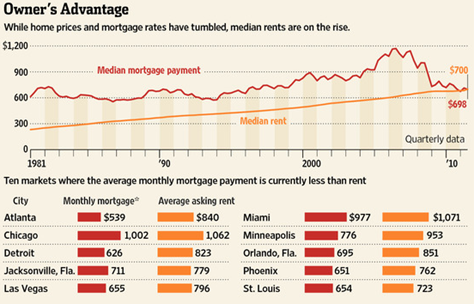 The Wall Street Journal’s third-quarter survey of housing-market conditions in 28 of the nation’s largest metropolitan areas found that home values declined in all but five markets compared with the second quarter, according to data from Zillow Inc. Meanwhile, rent levels have risen briskly across the country and mortgage rates, hovering around 4%, are the lowest in six decades.
The Wall Street Journal’s third-quarter survey of housing-market conditions in 28 of the nation’s largest metropolitan areas found that home values declined in all but five markets compared with the second quarter, according to data from Zillow Inc. Meanwhile, rent levels have risen briskly across the country and mortgage rates, hovering around 4%, are the lowest in six decades.
Read the rest here.
